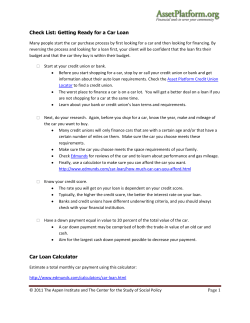
BSA/AML FOR INTERNATIONALLY HEADQUARTERED BANKS – HOW TO DEAL
BSA/AML FOR INTERNATIONALLY HEADQUARTERED BANKS – HOW TO DEAL WITH OTHER FINANCIAL INSTITUTIONS Presented to Institute of International Bankers Conference of State Bank Supervisors United States Regulatory Compliance Program 550 S. Hope Street Suite 2150 Los Angeles, CA 90071 Tel: (213) 243-3700 Fax: (213) 243- 3710 Email: wmix@lecg.com Websites: www.lecg.com www.securagroup.com By: Walter J. Mix III, Managing Director The Secura Group, of LECG, LLC July 16, 2008 2 How to Deal with other Financial Institutions-Summary Background Risk Factors Risk Mitigation Wire Activities Cash Activities Loan Participations Do’s and Don’ts Conclusion / Takeaways wmix@lecg.com 3 Background Secura/LECG’s market coverage is international. Types of financial services engagements include: Strategic and Financial Advisory, ERM, Credit Risk, BSA/AML, Compliance Risk Management, ALM/MARKET Risk, Basel II, Fair Lending, Capital Requirement/Allocation, various litigation matters, and others. Secura/LECG is a global expert services firm with over 800 experts and professionals in 13 countries. The firm provides independent expert testimony, original authoritative studies, and strategic advisory services to clients, including Fortune Global 500 corporations, major law firms, and local, state, and federal governments and agencies around the world. wmix@lecg.com 4 Background Banks must have a Fully Integrated/Implemented BSA/AML Program Enterprise level compliance program Risk assessment Policies and procedures Proper staffing Technology / software Training Audit/testing Surrounding documentation – Important! Continuously assess / rebalance as needed wmix@lecg.com 5 Background Potential Negative Sanctions – “Unsatisfactory Rating” FHC status No acquisitions/expansion in United States (well managed, well capitalized, satisfactory CRA rating and effective BSA/AML Program) Criminal sanctions by prosecutors Exposure to civil litigation Forfeiting bank license Civil money penalties Effective AML program Reputation and strategic risk Cost of developing BSA Program while operating under a regulatory order wmix@lecg.com 6 Background Getting Started Involve the Board, management, operations, lines of business, branches, legal, information technology, and others Must be a “team effort” that is enterprise-wide and integrates system capabilities, regulatory compliance and customer activity Must have “buy-in” from the Board, senior management and lines of business/departments Empower your risk management team and BSA Officer – important! Compliance culture Communicate with your regulator wmix@lecg.com 7 Risk Factors Customer Risk Factors to Consider No history or business relationship Unable to validate business practices or expertise Unable to validate BSA/AML Program: Policies Operating procedures System of controls Qualifications of staff wmix@lecg.com 8 Risk Factors Additional Risk Factors Foreign and domestic institutions/entities: Verifying ownership or control maybe difficult Public records may not reveal beneficial owners Corporate governance and controls may be minimal Financial reporting and records may be minimal Supervision may be minimal Never assume based on size or reputation! wmix@lecg.com 9 Risk Mitigation “Know Your Customer” What is the purpose of the transaction? Does the transaction make sense? Is the transaction normal or a “one-off?” What is the customer’s history with your bank? What is the customer’s history with the other institutions? wmix@lecg.com 10 Risk Mitigation Do you or the bank have experience with other the institution? Conduct due diligence – pre & post transaction Query news articles, review financial statements, review primary bank regulators’ website Understand and assess the risks of the transaction Establish a “score card” for the other financial institution wmix@lecg.com 11 Risk Mitigation Wire Activities Normal or unusual transaction (for customer & with other bank) Evaluate and monitor the volume of wires (sent/received) from specific institutions Type of other institution: Bank, S&L, Thrift, Credit Union Money transmitter Licensed to conduct the transaction or not wmix@lecg.com 12 Risk Mitigation Wire Activities (cont.) Due diligence of the other institution: Prior experience – good or bad Regulated or non-regulated Location/geography Domestic or foreign entity wmix@lecg.com 13 Risk Mitigation Cash Activities (retail operations – some foreign banks) Purpose of the cash transfers Ongoing or single transfers Regulated or non-regulated entity Level of regulatory review Check cashers Licensed to conduct the transaction Security wmix@lecg.com 14 Risk Mitigation Cash Activities (cont.) Evaluate the number and volume of transfers to specific entities Due diligence requirements: Written BSA/AML Program Site review/visitation Internet search/query Domestic or foreign entity wmix@lecg.com 15 Risk Mitigation Loan Participations Does the loan participation make sense? Who is initiating the participation (credit union or other institution)? Who is the “Lead Bank?” Are they experienced? Who will service the credit? Have they serviced similar loans/participations? wmix@lecg.com 16 Risk Mitigation Loan Participations (cont.) Does the underlying loan transaction make sense? Independently review and underwrite the credit Conduct and document OFAC Verify and document CIP Verify that loan documents support the purpose of the credit and borrower’s capacity to repay wmix@lecg.com 17 Risk Mitigation Loan Participations (cont.) Independently evaluate and underwrite the other participants Review the Participation Agreement Review ongoing servicing and transactions If appropriate, conduct a BSA/AML Risk Assessment Evaluate and monitor loan participations with specific institutions wmix@lecg.com 18 Risk Mitigation: Do’s and Don’ts Examples of BSA Failures Poor management oversight/accountability Weak risk assessment Failure of controls Poor reporting/ineffective communication Ineffective monitoring program Lack of enhanced due diligence Not responding to prior examination issues/findings Not preparing for the regulatory examination Failing to communicate with examiners wmix@lecg.com 19 Conclusion / Takeaways Be sure your bank’s BSA/AML Program addresses “Other Institution” transactions, among other requirements Determine if a transaction makes sense Know the transaction participants (KYC) Conduct BSA/AML Risk Assessments Monitor and document transactions/participants Think critically and ask questions “Proof is in the Pudding” Lesson from recent BSA/AML and “subprime” meltdown: Analyze “Worst Case” scenarios and properly implement your program wmix@lecg.com
© Copyright 2025









